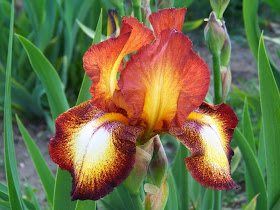by Dawn Mumford
On May 31st of this year we enjoyed some visitors to our iris garden. There were about 20 members of the American and Utah Iris Societies. They took pictures, smelled the aromas, looked at the flowers and "talked iris." I invited our guests to come in the house when they were done in the garden to have some chilled bottled water. I asked one of the gentlemen if he particularly liked any of the irises and he replied that he had made a list. He was interested in those irises that were 30 years old and older. According to him, that is how old they had to be to be considered "historic." It was at that moment that I realized how many I had that fit into that category. I hadn't looked at our irises that way. We have been growing irises since the 1980's and many were several years old when we bought them. That visitor made me look at my irises in a new light. I would like to share some of my favorite "oldies but goodies." here today.
'Aztec Treasure' ( R. and L. Miller 1984)
This bitone shows nice ruffling on both the falls and the standards.
'Praise The Lord' (Boushay 1972)
This self has rich blue color and contrasting white beards.
'Gold Trimmings' (Schreiner 1975)
Despite its age this iris has graceful ruffling and good branching.
'Chartreuse Ruffles' (Rudolph 1976)
I like the subtle coloring of this lilac, white, and chartreuse (green and yellow) bloom.
I don't advocate ridding the garden of new irises to plant only older varieties. But there are lots and lots of beautiful older irises that we should protect and not get rid of just for the sake of having something newer and marginally better. I grow the newer irises too and they are wonderful, but I have the luxury of plenty of room to put in the new ones without getting rid of the old ones. If you don't have the space for both old and new then you have a hard choice to make.
'Invitation' (Schreiner 1982)
This amoena has little ruffling or lace but has an elegant color combination.
'Heather Cloud' (B. Hammer) has much the same color combination as 'Celebration Song'.
'Extravagant' (Hamblen 1983)
This is one of my last to bloom and still surprises me with its beauty.
'Chocolate Shake' (Gibson 1982)
This one doesn't increase well for me but I like how unusual the colors are.
'Lemon Mist' (Rudolph 1971)
Blooms and blooms here and increases yearly.
'Gay Parasol' (Schreiner 1974)
This one is not a big bloom but has beautiful form and color.
'Geniality' (O. Brown 1981)
There is nothing old fashioned about this bloom.
"Beyond' (Gibson 1979)
A 35 year old plicata (stitched or stippled margin color on white or dots or peppering).
'Showcase' (Schreiner 1972)
Lots of color contrast in this plicata.
' Bayberry Candle' (C. DeForest 1969)
'Desert Mist' (Williamson 1980)
'Sky Hooks' (Osborne 1980)
What are some of your favorite older irises? If you have limited space, how do you make the decision on which ones to grow? How do you choose your irises? Is it based on color, form, time of year it blooms or by the hybridizers and the year? Is it by hardiness or cost? In the past I have just chosen irises based on color and form but I am learning to pay more attention to the name of the hybridizer and the year it was introduced. It is a surprise to me that I have chosen so many historics. And remember, each year more historics are added to the list!



























































